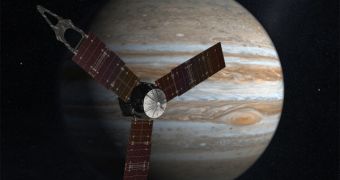Engineers at the Cape Canaveral Air Force Station (CCAFS) moved the NASA Juno spacecraft to its designated takeoff site yesterday, July 27. The maneuver was then followed by the mating of the probe with its Atlas 5 delivery system, that will take it to Jupiter.
At this point, Juno is scheduled to launch on Friday, August 5, on a mission that will take about half a decade to reach its destination. Once it enters the Jovian system, the probe will begin to carry out advanced scientific studies of the gas planet.
It will fly a total of 33 orbits around Jupiter, while analyzing its atmospheric composition, its magnetosphere, as well as its interactions with its complex moon and ring systems. This should lead to a better understanding of the planet's observed properties.
NASA doesn't have nearly as much information on Jupiter as it does on Saturn, where the Cassini orbiter has been conducting research since achieving orbital insertion, on July 1, 2004, Space reports.
But Juno aims to address this lack of data. By analyzing the origins and evolution of Jupiter, the probe will solve another piece of the puzzle that is our solar system. NASA invested about $1.1 billion in this spacecraft, and the agency is expecting great things from it.
“We're about to start our journey to Jupiter to unlock the secrets of the early solar system. After eight years of development, the spacecraft is ready for its important mission,” says Scott Bolton, a researcher at the San Antonio, Texas-based Southwest Research Institute (SwRI).
He is also the principal investigator of the new mission. Juno is managed by experts at the NASA Jet Propulsion Laboratory (JPL), in Pasadena, California. The probe is a components of the New Frontiers Program managed by the NASA Marshall Space Flight Center (GSFC), in Huntsville, Alabama.
Experts expect the mission to reach its destination in July 2016. Carrying out the 33 orbits will take Juno about on Earth year. Following the new studies, astronomers will have a much better understanding of how the largest planet in our solar system formed.
“If we want to go back in time and understand where we came from and how the planets were made, Jupiter holds the secret, because it's got most of the leftovers after the Sun formed,” Bolton explained.
“We want to know that ingredient list. What we're really after is discovering the recipe for making planets,” he told reporters in a recent press briefing.
“Juno's prepared to be able to help constrain those answers, and help provide that information so that we can discriminate among models of how Jupiter formed and, in fact, what the history of our early solar system was,” Bolton concluded.

 14 DAY TRIAL //
14 DAY TRIAL //